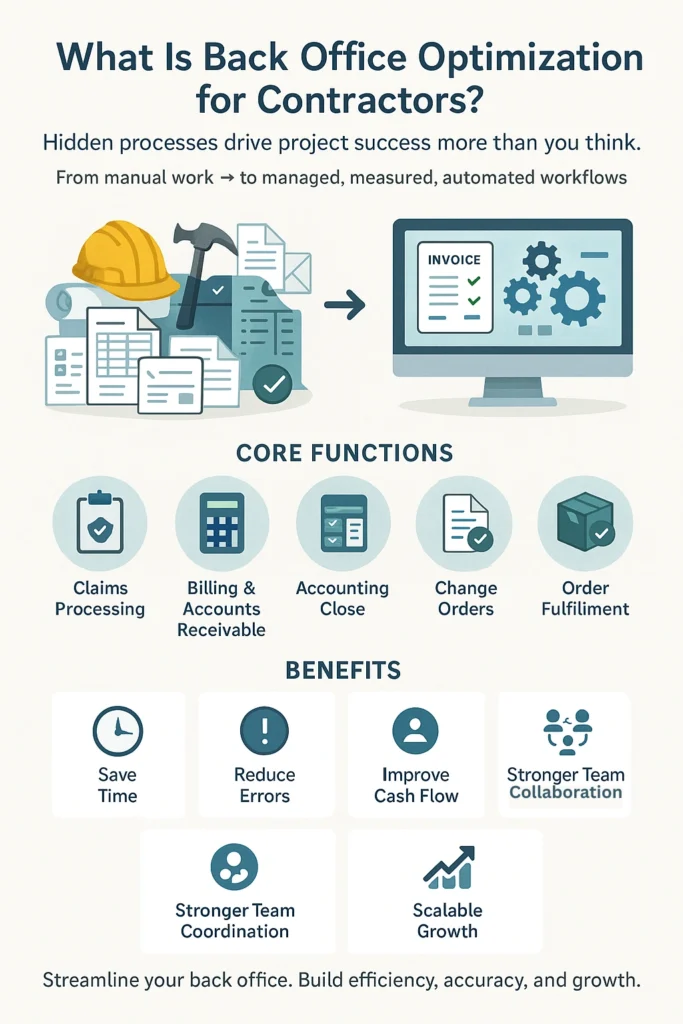Back office optimization for contractors is the process of streamlining all administrative and operational tasks that support fieldwork and project delivery. It includes improving workflows for accounting, payroll, project documentation, compliance, and reporting.
Effective back office optimization reduces manual work, minimizes errors, and provides real-time visibility into financials and project performance. For contractors, this means faster invoicing, more accurate record-keeping, and smoother coordination between teams, ultimately increasing efficiency and profitability while allowing the business to scale more effectively.
Key Takeaways
- Back office optimization streamlines administrative tasks, reducing errors and saving contractors valuable time.
- Automated workflows improve cash flow and ensure timely invoicing and accurate financial tracking.
- Centralized processes enhance team coordination and prevent miscommunication across projects.
- Data-driven insights enable smarter decision-making and better resource allocation for contractors.
- Partnering with experts like Natalie Luneva and using tools like DepositFix creates a scalable, efficient, and profitable back office.
What Is Back Office Optimization for Contractors
Hidden processes, claims handling, accounting closes, and fulfillment, drive project rhythm more than you think. You can treat these non-customer routines as a managed element of your operation rather than a constant source of delay. Running a successful service business isn’t just about customer-facing excellence; it also depends on how smoothly your back office operates.
Core functions you should target
Your core functions include claims processing, billing and accounts receivable, accounting close, change orders, and order fulfillment. These areas create downstream bottlenecks when managed with spreadsheets and email chains.
From manual work to managed, measured, automated workflows
Map how work arrives and who does it. Standardize intake and routing so tasks reach the right person with the right data the first time. Replace ad hoc queues with managed queues that make progress visible and enforce service levels.
- Target repetitive tasks for automation to cut keying errors and speed cycle times.
- Measure baseline performance, volumes, handle time, backlog, and error rates, to set realistic targets.
- Use light technology to support workflows without overbuilding tools your team won’t adopt.
Benefits of Back Office Optimization for Contractors
Back office optimization brings multiple advantages that help contractors run their businesses more efficiently and profitably:
- Time Savings: Automating administrative tasks like invoicing, payroll, and compliance tracking reduces manual work, freeing up time to focus on projects and client relationships.
- Error Reduction: Streamlined processes minimize mistakes in billing, documentation, and reporting, preventing costly errors and delays.
- Improved Cash Flow: Accurate and timely invoicing ensures faster payments, giving contractors better control over finances.
- Enhanced Decision-Making: Real-time access to financial and project data provides insights for smarter planning and resource allocation.
- Better Team Coordination: Centralized project information keeps teams aligned, improving collaboration and reducing miscommunication.
- Scalability: Efficient back office systems create a strong foundation, making it easier to grow the business without adding unnecessary administrative burden.
Optimizing the back office allows contractors to focus on delivering quality work while maintaining a streamlined, organized, and profitable business.

Why Back-Office Operations Shape Customer Experience and Service Outcomes
When orders miss windows or claims are wrong, the customer sees a broken promise. These errors cause refunds, callbacks, and extra field visits that erode trust and raise costs.
Missed promises become visible moments
Missed promises become visible moments. Late fulfillment or faulty claims force you to fix problems rather than deliver value. With optimized processes, contractors deliver smoother projects, reduce rework, and create more capacity for growing a service business.
Reduce avoidable interactions
Poor upstream processes push volume to your contact center. Agents spend time resolving preventable issues, which uses scarce resources and hurts customer service metrics.
Make every touchpoint consistent
Standardize checks, sync SLAs with field appointments, and share status proactively. These moves shorten time-to-resolution and lift first-contact resolution.
- Use complaint insights to fix root causes.
- Align internal service levels with delivery windows.
- Track error rates to protect margins and boost satisfaction.
| Issue | Impact | Fix |
| Late fulfillment | Refunds, lost trust, extra calls | Proactive updates and SLA alignment |
| Incorrect claims | Rework, delays, margin erosion | Standardized quality checks and validation |
| High call volume | Agent overload, higher handling cost | Process fixes and call-deflection data |
Back Office Optimization Methodology: From Analysis to Implementation
A clear methodology helps you move from noisy handoffs to steady throughput. The approach splits work into timed phases so teams can act with confidence and measure success.
Phase: Analysis (4–6 weeks)
Begin with a 4–6 week diagnostic that compares departments, maps activities, and surfaces bottlenecks. You will review the current management model to see decision rights, escalation paths, and how work is scheduled and tracked.
Collect the right data at activity and process levels so you can quantify delays and error drivers.
Phase: Design (2 weeks)
Run a focused, two-week workshop with company leadership to define target-state workflows. Prioritize initiatives and quantify savings so you know where to allocate resources first.
Produce a short recommendations pack that ties changes to measurable value and adoption steps.
Phase: Implementation (4–8 months)
Build a phased plan that sequences pilots, rollouts, and change management over 4–8 months. Form joint working groups with clear objectives to co-own outcomes and remove blockers fast.
Provide on-the-spot support, coaching, job aids, and quick configuration tweaks, so the workforce adopts new ways of working without huge drops in performance.
Ongoing evaluation and completion
Instrument processes with key metrics from day one. Track throughput, aging, and quality, then use early insights to focus on the highest-return changes.
Continuous evaluation ensures improvements stick and that your organization keeps refining operations with the right mix of people and technology.
- 4–6 week analysis: diagnose, compare, document.
- 2-week design: prioritize and quantify value.
- 4–8 month rollout: pilots, working groups, on-the-spot support.
- Ongoing: measure, adjust, and complete.
| Phase | Duration | Primary Output |
| Analysis | 4–6 weeks | Department comparisons, process maps, management model review |
| Design | 2 weeks | Target workflows, prioritized roadmap, quantified savings |
| Implementation | 4–8 months | Sequenced rollouts, working groups, adoption support |
| Ongoing | Continuous | Performance tracking, iterative improvements, completion criteria |
Key Tools and Techniques: Workforce Management, Task Queuing, and Automation
Aligning schedules, queues, and simple automation reduces firefighting and lifts team productivity. You adopt methods from the contact center to make work predictable and measurable.
Start with workforce planning. Forecast incoming volumes, match skills to demand, and prevent bottlenecks before they form. This keeps employees busy on the right work and protects throughput.
Applying call center disciplines to back-office work for consistent performance
Use managed queues that sort tasks by priority, skill, and due date so the next best item is always clear. Combine these queues with automation to pre-validate forms, auto-populate fields, and trigger follow-ups.
- Standardize workflows in a fit-for-purpose platform so every employee follows the same steps and quality checks.
- Set clear performance targets, throughput, aging thresholds, and right-first-time rates, and show them on visible dashboards.
- Increase productivity and batch similar work, reduce context switching, and enforce schedule adherence.
- Give team leads real-time data to rebalance queues and move employees where they yield the greatest service impact.
| Tool | Primary Benefit | Example Use |
| Workforce planning | Aligns staffing to peaks | Forecast daily task volume and schedule shifts |
| Managed queues | Reduces routing delay | Route tasks by skill and due date |
| Automation | Cuts errors and speed | Auto-validate inputs and trigger follow-ups |
Finally, integrate with upstream systems so requests arrive complete. Task-level audit trails then make compliance, training, and root-cause analysis faster and clearer.
Measuring Operational Efficiency: Data, KPIs, Compliance, and Cost Savings
If you can see cycle times and defects at a glance, you can act before customers feel the impact.
Define a balanced KPI set that covers volume, speed, quality, backlog health, and customer impact for each area. Use these measures to link efficiency to margin and service.
Establish data standards and a single source of truth so leaders compare performance without arguing numbers. Timestamped handoffs and queue visibility give clear evidence of where delays happen.
Embed compliance controls, segregation of duties, approvals, and audit trails, into workflows to cut rework and reduce regulatory risk.
- Track cycle times, touch counts, and right-first-time rates to measure operational efficiency.
- Quantify cost savings from fewer defects and lower handling time, then reinvest gains into higher-impact changes.
- Create simple dashboards and aligned review cadences, daily standups, weekly ops reviews, monthly close, to turn insights into action.
| KPI | Definition | Target | Business Impact |
| Cycle time | Average end-to-end processing hours | <24–48 hours | Faster delivery, fewer escalations |
| Right-first-time | % items completed without rework | >95% | Lower cost, better customer trust |
| Backlog aging | Count of items past SLA | Zero critical aging | Improved throughput, stable capacity |
| Compliance rate | % workflows with required checks/audits | 100% for regulated steps | Reduced risk, cleaner audits |
Best Practices for Optimizing Back-Office Processes in Your Organization
Consolidating tools and clarifying roles turns chaos into predictable delivery. Start small: pick a few high-volume processes and make them repeatable. That creates early wins you can scale across the organization.
Avoiding common pitfalls
Fragmented platforms and manual rekeying cause errors and slow progress. Siloed teams hide queue pressure and duplicate effort.
Remove these risks, reduce tool sprawl, and document handoffs. Shared SLAs and visible queues keep everyone aligned.
What good looks like
Standardized workflows, clear priorities, and focused training help employees follow the same playbook. Allocate resources dynamically so you shift capacity to priority queues without breaking controls.
Use lightweight technology and selective automation to remove low-value steps while keeping humans in the loop for judgment calls.
- Consolidate core processes into a single, easy-to-use platform to cut rekeying and confusion.
- Define process owners, escalation paths, and metrics in a short playbook that teams can follow.
- Provide regular training, job aids, and ongoing support, coaching and office hours, to sustain gains.
| Practice | Benefit | How to start |
| Platform consolidation | Fewer errors, higher productivity | Map core tools and retire duplicates |
| Dynamic resource allocation | Stable turnaround, protected SLAs | Use visible queues and short-term reassignments |
| Targeted training | Faster adoption, fewer exceptions | Run brief, scenario-based sessions and refreshes |
Optimize Your Back Office Operations with Natalie Luneva
Is your back office draining over 20% of your revenue? You’re not alone. Many contractors face this challenge. But with the right strategies and tools, you can turn things around.
Natalie Luneva specializes in transforming the back office operations of contractors, including HVAC, plumbing, roofing, and electrical businesses. Through her “Back Office in a Box™” approach, she integrates essential functions, finance, marketing, operations, and compliance, into a cohesive system that drives efficiency and profitability.
Natalie partners with DepositFix, a powerful payment automation platform, and offers a comprehensive solution to streamline your billing and payment processes.
Key Features of DepositFix
- Customizable Payment Forms: Create branded forms that capture the exact information you need.
- Multiple Payment Methods: Accept credit cards, ACH, PayPal, and more, providing flexibility for your clients.
- Automated Invoicing & Collections: Reduce manual work and improve cash flow with automated billing and reminders.
- CRM Integration: Sync payments directly with your CRM, ensuring seamless data flow and reducing errors.
- Subscription Management: Easily manage recurring billing and payment plans.
Benefits for Contractors
- Enhanced Cash Flow: Accelerate payments and reduce late fees.
- Operational Efficiency: Free up time and automate routine tasks.
- Improved Client Experience: Offer a seamless and professional payment process.
- Real-Time Insights: Access up-to-date financial data for better decision-making.
- Scalability: Support business growth without adding administrative overhead.
Ready to optimize your back office and boost your bottom line? Schedule a free 30-minute consultation with Natalie Luneva to uncover your biggest growth opportunities. Together, you can implement smart systems and strategies that lead to sustainable success.

Conclusion
Optimizing back office operations is essential for contractors who want to increase efficiency, reduce errors, and grow profitably. When contractors streamline workflows, automate tasks, and improve visibility into financials and project performance, they can focus on delivering quality work while maintaining smooth operations.
With the guidance of Natalie Luneva and tools like DepositFix, contractors gain expert strategies and practical solutions to transform their back office, boost cash flow, and build a scalable, high-performing business.
FAQs
How long does it take to see results from back office optimization?
Initial improvements in efficiency, error reduction, and cash flow can be visible within 1–3 months after implementing streamlined processes and automation. Full-scale benefits, such as significant time savings, measurable ROI, and scalability, typically occur within 6–12 months, depending on the complexity of the workflows and adoption by the team.
Which technologies are most effective for back office optimization?
Key technologies include workflow management platforms, automated invoicing and payment systems, CRM integrations, document management software, and light automation tools. The goal is to simplify manual work, ensure data accuracy, and provide visibility without overwhelming staff with overly complex systems.
How can contractors measure the ROI of back office optimization?
ROI can be measured by tracking reductions in processing errors, cycle times, backlog volumes, and labor hours spent on manual tasks. Additional metrics include faster payments, improved cash flow, fewer client complaints, and increased throughput across projects.
Are there common mistakes contractors make when optimizing the back office?
Common mistakes include overcomplicating systems, trying to automate too many tasks at once, failing to define clear process ownership, and neglecting staff training. These missteps can slow adoption and reduce the effectiveness of optimization efforts.
Can small contracting businesses benefit from back office optimization?
Absolutely. Even small businesses benefit from streamlined processes, automated invoicing, and centralized documentation. Early optimization helps prevent errors, improves client satisfaction, and lays the foundation for scalable growth as the business expands.
How do you choose which processes to optimize first?
Start with high-volume, repetitive, or error-prone tasks that have the largest impact on cash flow, client satisfaction, or operational efficiency. Examples include invoicing, change order management, claims processing, and vendor payments. Quick wins in these areas often fund larger optimization projects.
How does back office optimization integrate with field operations?
Optimized back office systems provide real-time updates to project managers and field teams, ensuring schedules, change orders, and client communications are accurate. This reduces delays, prevents miscommunication, and ensures the field team can complete projects efficiently without waiting for missing approvals or information.


